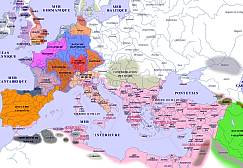Leontius

An Online Encyclopedia of Roman Emperors
Leontius (695-98 A.D.)
R. Scott Moore
Ohio State University
 (c) 1999 Chris
Connell
(c) 1999 Chris
Connell
Accession
Of Isaurian origin, Leontius was a very efficient military leader and served capably under several emperors. Constantine IV appointed him strategos of Anatolikon. Justinian II sent him to campaign against the Arabs in Armenia and Georgia, in 686. Defeating the Arab raiders, Leontius campaigned successfully into Azerbaijan and Albania, gathering loot and gaining a reputation for cruelty. This campaign convinced the Caliph cAbd al-Malik to renew his treaty with the Byzantines, originally signed during the reign of Constantine IV, with more favorable terms for the Byzantine Empire. The Caliph agreed to share the income from Armenia, Iberia, and Cyprus and increased the amount of yearly tribute paid to the Byzantines. In 692, after a Byzantine defeat at the battle of Sebastopolis due to the desertion of a large contingent of Slavs, Justinian II, holding Leontius responsible, imprisoned him in Constantinople. In 695, after further setbacks against the Arabs, Justinian II released Leontius and appointed him strategos of Hellas. Leontius, once freed from prison, quickly organized a rebellion against the emperor. With support from the Blue faction and the patriarch Callinicus, Leontius and his followers seized Justinian II and proclaimed Leontius as emperor. Leontius had Justinian's nose and tongue slit and him exiled to Cherson in the Crimea.
Reign and Fall
Leontius took the name Leo when he became emperor and attempted to steer a more moderate political course than his predecessor. Restricting the movement of the army, Leontius allowed small raids on the edges of the empire to go unpunished and focused on consolidation. In 696 cAbd al-Malik, emboldened by Leontius' apparent lack of aggressiveness, was able to initiate an attack against Byzantine Africa that resulted in the capture of Carthage in 697. Leontius entrusted John the Patrician with the task of retaking Byzantine Africa and using a sudden appearance in Carthage's harbor, John was able to take the city. Arab reinforcements soon forced John's troops from the city and they retreated to Crete to regroup. Fearing the emperor's anger at their failure, a group of officers revolted, deposed John and proclaimed Apsimar, drungary of the Cibyrrhaeots, as emperor. Apsimar gathered a fleet and sailed on Constantinople which was being ravaged by the bubonic plague. The city withstood the siege for several months before the gates were opened for the rebels in 698. Apsimar, who took the name Tiberius II, had Leontius' nose slit and him imprisoned in the monastery of Psamathion in Constantinople. When Justinian II returned to power in 705, he had Leontius paraded through the city before he was beheaded.
Primary Source Bibliography
Nicephorus. Chronigraphikon syntomon.
Theophanes. Chronographia.
Bibliography
Bury, J.B. The Later Roman Empire from Arcadius to Irene (395-800). London, 1889.
Grierson, P. Catalogue of the Byzantine Coins in the Dumbarton Oaks Collection and in the Whittemore Collection, vol. II:Phocas to Theodosius III, 602-717. Washington, 1968.
Haldon, J.F. Byzantium in the Seventh Century: the transformation of a culture. Cambridge, 1990.
Kaegi, Jr. Walter Emil. Byzantine Military Unrest, 471-843: an interpretation. Amsterdam, 1981.
Kazhdan, Alexander P. Oxford Dictionary of Byzantium. New York, 1991. S.v. "Leontius" by Paul A. Hollingsworth.
Ostrogorsky, George. Geschichte des byzantischen Staates. Munich, 1963.
Stratos, A.N. Byzantium in the Seventh Century. Amsterdam, 1968.
Treadgold, Warren. A History of Byzantine State and Society. Stanford, 1997.
Vasiliev, A.A. History of the Byzantine Empire. Madison, Wisconsin, 1952.
Copyright (C), R. Scott Moore. This file may be copied on the condition that the entire contents, including the header and this copyright notice, remain intact.
For more detailed geographical information, please use the DIR/ORBAntique and Medieval Atlas below. Click on the appropriate part of the map below to access large area maps.

 DIR Atlas
DIR Atlas